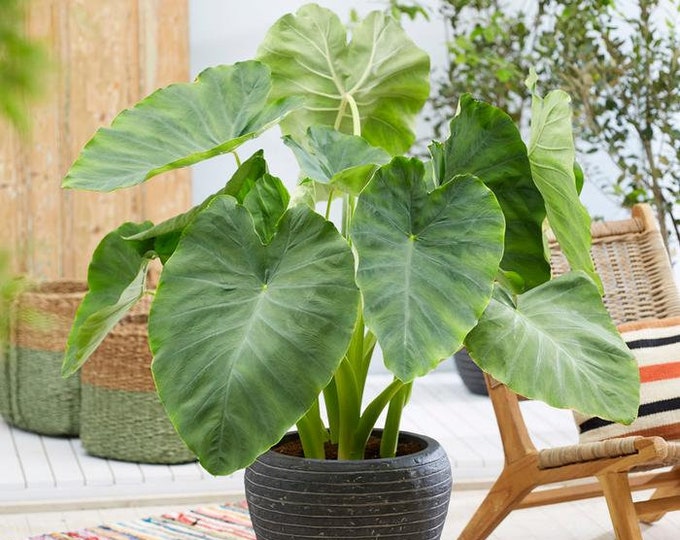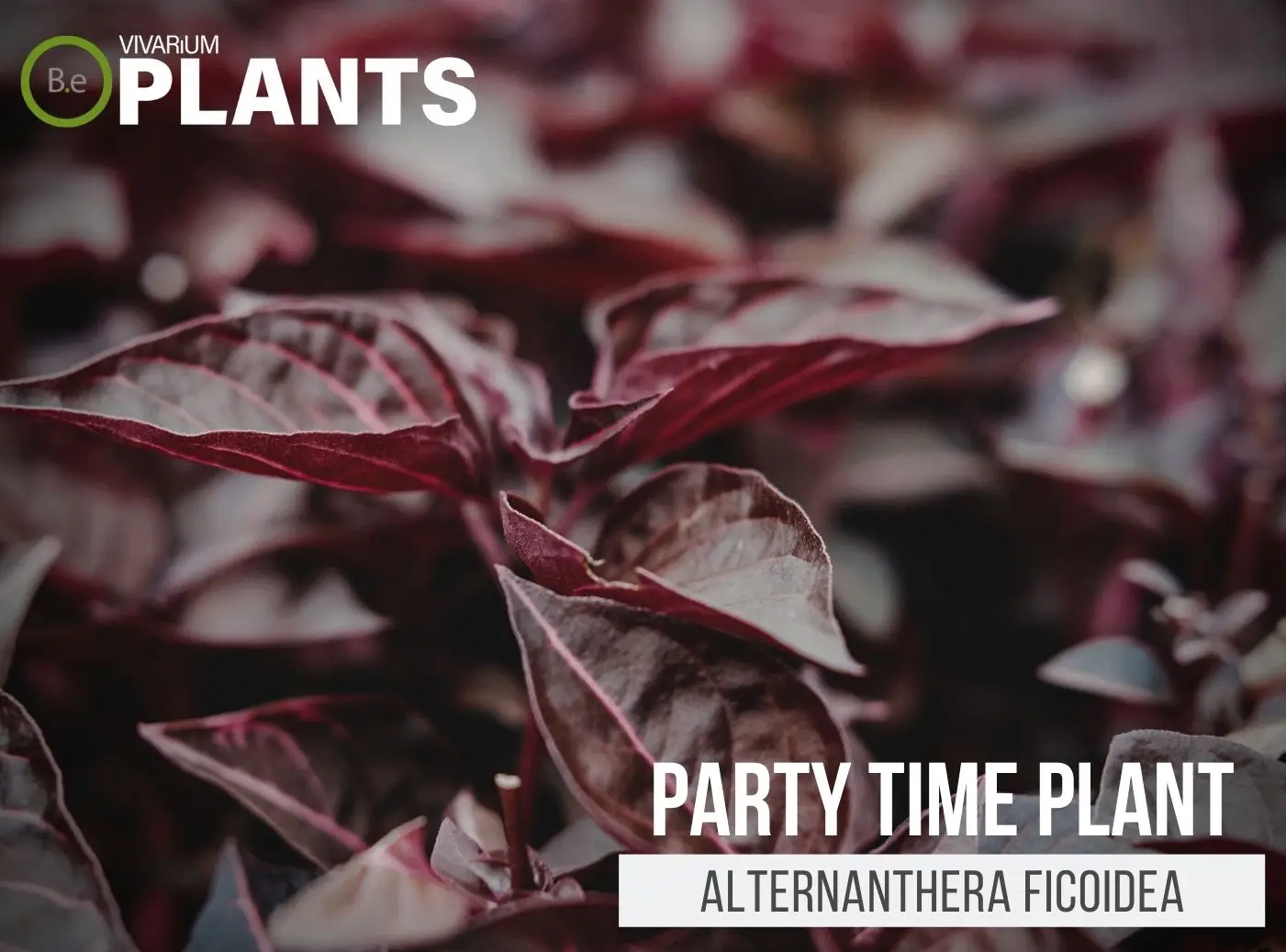Colocasia esculenta, more commonly known as Elephant Ear Plants, are an amazing and eye–catching addition to a vivarium.
While these plants look like large-leafed tropicals, they truly thrive in cooler temperatures that make them easier to maintain.
Elephant Ear plants have beautiful large foliage that will make your vivarium look lush and vibrant. They are an excellent choice for terrariums that require a bit of a low-maintenance plant.
Table Of Contents:
ToggleQuick Stats:
Scientific Name: Colocasia esculenta
Family: Araceae
Common Names: Elephant Ear Plant, Taro Plant, Giant Taro
Habitat: Semi-aquatic/Moist
Height: 4-6 feet
pH Range: 5.6 – 7.6
Temperature: 50°F to 85°F
What Is An Elephant Ear Plant?
Elephant Ear Plants, also known as Colocasia esculenta, are semi–aquatic perennials with large green and dark green heart-shaped leaves.
Elephant Ear Plants are rhizome plants with big, swollen underground stems and fibrous roots. These plants can grow to be a few feet tall (up to 3 feet).
The leaves are usually a bright glossy green, but some have purple or purplish–brown accents. They also have short stems and can also be used as stem plants.


Elephant Ear Plant Facts
Elephant Ear Plants are native to Southeast Asia, India, China, and the southeast portion of the United States.
These plants will contain some level of oxalic acid and should be avoided by small children, who may be tempted to eat them.
Like other members of the Colocasia genus, these plants need moist and well–drained soil.
Description
Elephant Ear Plants are so named because of their immense size and heart–shaped leaves. The leaves, which are up to 3 feet in length, are glossy green and either lobed or non–lobed.
The leaves are supported by a short, thick stem and the leaves are often speckled with darker colors. The leaves of the elephant ear plant can be potted in soil or submerged in the aquarium to act as a filter plant.
Habitat
In their native habitat, Elephant Ear Plants are found in Southeast Asia, India, China, and the southeast portion of the United States.
The plant grows well in waterlogged or moist soils, as well as in streams and ponds. The plant prefers regions where the temperature is between 50°F and 85°F.
pH Preference
Elephant Ear plants prefer a slightly acidic to neutral pH range of 5.6 to 7.6.
They will tolerate a wider range of pH, but there are certain lethal values of pH that must be avoided.
Maintaining a proper pH is important for the overall health and growth of the plant.
Vivarium Type
The Elephant Ear Plant is quite an easy-going species. With that in mind, it will not be too complicated when choosing the type of enclosure it is grown in. It is best to try and replicate the plant’s natural habitat as much as possible.
Doing so will make it easier to provide this foliage plant with its basic needs. The proper setup and theme of the enclosure will make a big difference to the overall look and health of the plant. Be sure to choose setups that are moist and high in humidity.
Here are recommended vivariums it will do well in:
-
- Paludariums – Half aquatic/ half terrain-based enclosure.
- Ripariums – Mostly aquatic-based enclosures with some terrain features present.
- Terrariums – Fully terrain-based enclosures with little to no aquatic features.
Vivarium Placement
Because of their large size, Elephant Ear Plants should be placed in the background of a terrarium.
Make sure that when placing the plant in the vivarium, the leaves are not shoved against the sides of the tank.
This could lead to damage to the foliage. If possible, create a moat with gravel or sand to help keep the leaves from getting squashed.
Substrate
Elephant Ear Plants are best grown in a nutrient–dense substrate such as clay or aquatic soil. If the plant is potted, a heavy loam or muck soils work best.
If the plant is to be planted directly into the substrate of your vivarium, use a substrate that contains good organic matter.
Make sure that the substrate is well–drained, as the plant prefers a moist but not wet rooting area.
Lighting
These plants do best when given bright indirect lighting. Place the plant near a window or in a vivarium with slightly dimmer terrarium lighting. The plants prefer partial shade, and too much direct sunlight could burn their leaves.
Buy Elephant Ear Plant
When buying an Elephant Ear Plant, there are a few things to keep in mind. Making sure the plant is healthy when purchased is essential for its success in a vivarium or pond. Vegetation that is already in poor conditions will have a very hard time adjusting to new environments.
Click the image below to learn more about the current price and other relative info about this plant.
Elephant Ear Plant Care & Propagation
Elephant Ear Plants are relatively easy to propagate and care for. They can be propagated by cuttings or by dividing the plant.
Once the new plants are established, they can then be potted or planted into the substrate.
To care for the plant, make sure that it is planted in moist, well–drained soil and that the pH is kept within its preferred range.
How To Grow
Elephant Ear Plants prefer moist soils, so fertilize them once a month with a balanced nitrogen, phosphorus, and potassium fertilizer.
When growing multiple plants, space them about 6 to 8″ apart as the roots may intertwine and crowd each other out.
Water Requirements
Elephant Ear plants need plenty of water and should be watered every other day.
If the soil dries out completely, the plant will start to wilt and die.
When watering the plants, use room temperature water and avoid using cold water which can shock the plant.
Plants Similar To Elephant Ear Plant
Adding diversity to an enclosure is key to an aesthetically pleasing setup. Try mixing up the look of your vivarium with different flora that can easily co-exist in the same types of environment.
Furthermore, if for some reason you find the Elephant Ear Plant hard to acquire or would like to consider something similar to this plant… Here are other pond plants you might see will do well with or in place of Colocasia esculenta:
Conclusion
Overall, Elephant Ear Plants are great additions to a terrarium and they are relatively low maintenance. They add a lush element of greenery and also add some more interesting elements to any type of vivarium.
They can be grown in and out of the water, depending on the environment in which they are placed. If properly taken care of, these plants will add life and vibrancy to any vivarium.
Frequently Asked Questions
Colocasia esculenta can grow up to 4–6 feet (1.2–1.8 m) tall.
Yes, Colocasia esculenta (also known as Elephant Ears or Taro) is poisonous if ingested. The plant contains oxalic acid and calcium oxalate crystals, which can cause skin irritation and gastrointestinal problems if ingested.
If you touch an elephant ear plant, you may experience mild, temporary skin irritation and/or a tingling sensation on your fingers.
Yes, you should cut off damaged elephant ear leaves. It is best to prune off any leaves that are discolored, turning yellow or brown, or have holes or damage. This will help to keep the plant healthy and promote new growth.
Elephant ear plants need partial sun to partial shade to thrive. They prefer to receive 4 to 6 hours of sunlight per day, but can tolerate more if necessary. They also need consistent moisture for best growth.
Elephant ears should be watered frequently and deeply. During the summer, water the soil every 5–7 days, and during the cooler months, water every 10–14 days. Make sure the soil is not allowed to dry out completely. Check for dryness by sticking your finger into the soil; if it feels dry to the touch, it needs to be watered.






